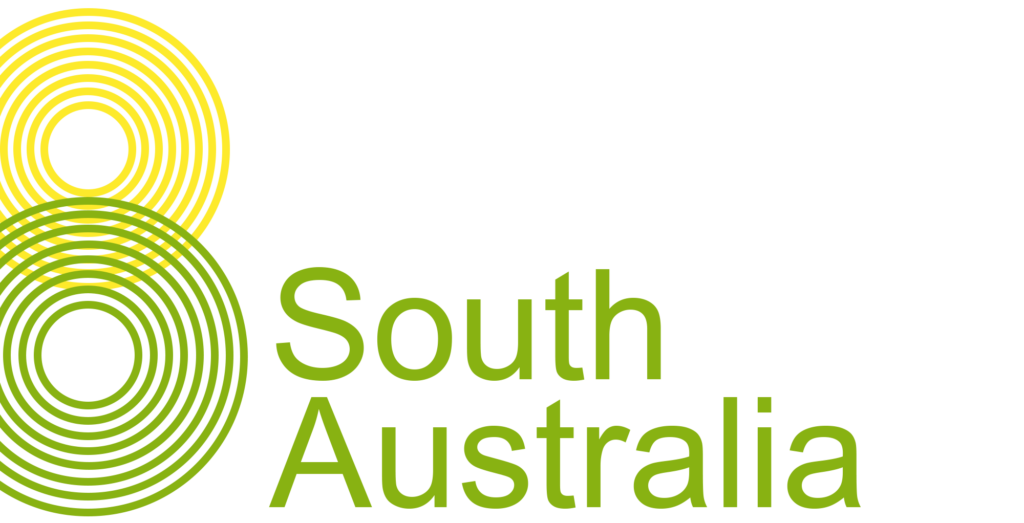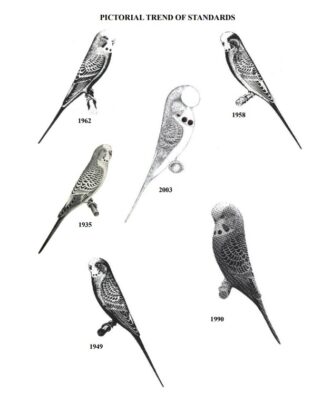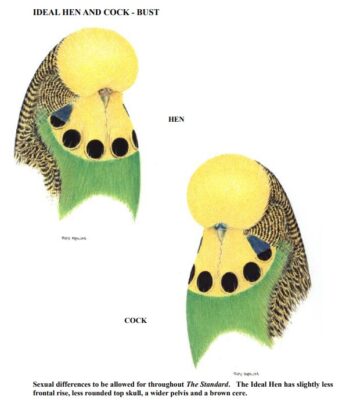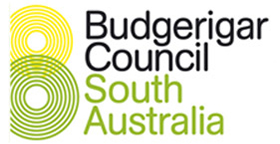
The General History of the Wild Budgerigar

Many authors have written several fantastic books on the history of the budgerigar. The budgerigar is a unique Australian species, they are nomadic occurring over the vast grassy inland plains of Western Australia, Northern Territory, Queensland, Victoria and South Australia. Flocks of consisting of many thousands of individual birds can be observed during ideal seasonal conditions. They have been noted in many general history ledgers, with the earliest notes by Gould.
Budgerigars are gregarious nesting in large colonies of dozens of pairs during breeding. Breeding generally occurs during the warmer months when seeding grasses and water are in abundance. Budgerigars do not use any nesting material, preferring to nest in hollows formed by burrowing into the rotting wood of Eucalypt trees where they will lay four to six eggs on alternate days, the incubation period is 18 days. The young budgies will fledge after approximately 30 days.
The wild budgerigar is approximately 18 centimeters in length, has a 30cm wingspan, and weighs between 30 to 40 grams. The wild budgerigar exhibits a grass green rump and underparts, has a bright yellow face and a dark blue tail. The budgerigar mantle, the back and wing coverts (upper & under), are black with yellow outlining. To illustrate, the budgerigar mask is adorned by three large black spots on each side of the face, the outer spots partially covered by the violet cheek patches reflecting ultraviolet light which is only visible to the budgerigar. What’s more, the wild budgerigar has a black eye with white iris, and the feet are grey/blue in color. Color mutations are a natural phenomenon and wild budgerigars are no exception with blue and yellow mutations having been reported since the 1800’s.
Origins of the Name “Budgerigar”
When considering the history of the budgerigar, it is important to understand that the name budgerigar originates from the Aboriginal term ‘Betcherrygah,’ meaning good tucker. People made the first recordings of budgerigars in the early 1800s. English botanist John Gould accurately described budgerigars in their native habitat and returned to the UK with a pair of budgerigars around 1840.
The Latin name for the budgerigar is Melopsittacus Undulatus, Melopsittacus a Greek word meaning melodious parrot and Undulatus describing the budgerigars scalloped wing pattern. Other colloquial names used are warbling grass parrot, shell parakeet, zebra parrot, or scallop parrot.
Mutations of the Budgerigar Over Time
There are already more than 30 primary mutations present in the Budgerigar, which allows for the possibility of hundreds of secondary mutations and colour variants. For more information on the varieties, check out the Varieties tab.
Evolution of the Exhibition Budgerigar Standard
The pictorial trend of The Standard illustrates the development of the exhibition Budgerigar.  These represent the standard in 1935, 1949, 1958, 1962, 1990, and 2003, as well as the evolution of the show budgerigar through time. The first four drawings span a period of 27 years, from 1935 to 1962. However, in the 1990 and 2003 versions, significant differences may be seen.
These represent the standard in 1935, 1949, 1958, 1962, 1990, and 2003, as well as the evolution of the show budgerigar through time. The first four drawings span a period of 27 years, from 1935 to 1962. However, in the 1990 and 2003 versions, significant differences may be seen.
The Australian National Budgerigar Council (ANBC) Hall of Fame
In May of 2003, the Australian National Budgerigar Council (ANBC) agreed to create a ‘Hall of Fame’ with an initial breeder excellence section. The total includes all ANBC National Class victories since 1983. The ANBC has also developed the ‘Breeder Excellence’ award to publicly recognize the work of certain breeders who promote the hobby at the highest level and to celebrate their effort and accomplishment. During the ANBC National Competition Show on Sunday evening, inductees are introduced and awarded at the Presentation Dinner. These are the requirements for admission into the Breeder Excellence Division of the Hall of Fame:
- An exhibitor (or partnership) winning classes on seven (7) occasions, or
- An exhibitor (or partnership) winning the same class on four occasions.
Service division – Honour roll for Service
In October 2009 the A.N.B.C. Inc decided to establish a further division ‘ Honour Roll – for Service’. They inducted five ANBC Founding Fathers into this Division on May 30th, 2010.
General History of The Budgerigar Council of South Australia (BCSA)
The Budgerigar Council of South Australia officially formed on April 12th, 1996, upon completion of the constitution. From that point in time, the BCSA directed all ANBC matters relating to budgerigars. For more information on the BCSA, check out the BCSA History.
General History of Budgerigar Importation to Australia
They stopped importing budgerigars into Australia in 1992. There has been a recent risk assessment, to establish the viability of reopening the importation channel.
Formation of the ANBC & The National Titles
In 1964, Budgerigar Fanciers from Victoria, New South Wales, and South Australia gathered for The Griffith Cage Bird Societies Annual Show in Griffith, NSW. To this end, the idea of a National Teams Competition for Budgerigars formed. Dr. Harold Cooper from New South Wales (now Tasmania) began discussing a Teams Competition with The Late Frank Gardener from Victoria in 1972. These two enthusiasts recruited Harry Eady and Evan Stafford from Victoria, Ron Hunt from NSW, and George Duffield from South Australia to assist in generating interest inside the Fancy. In 1974, Harry Eady persuaded The BCA (now BCV) to sponsor a Teams Competition, making these early thoughts a reality.
A Teams Competition
They conducted the first Teams Competition in 1975 in the Melbourne district of Kensington. To clarify, Victoria, NSW, and SA participated in this first event, which is now an annual competition. Western Australia entered the competition in 1978, followed by North Queensland, South Queensland, and Tasmania in 1979, 1980, and 1983, respectively. In 1981, it became necessary to form a governing body to establish the regulations for this competition. To that end, a steering committee comprised of participating teams convened throughout the tournament in Perth, WA. To list, Alan Marshall and Ron MacNamara from Victoria, Brian West and Amon Murdock from Queensland, Bruce Bradford, Kevin Kelly, and Col Morgan from NSW, Don Geary from the ACT, George Duffield and Stan Watson from SA, and Willie Schoeman from WA were the delegates.
The ANBC chose Mr. Brian West as its first Secretary, and they decided to hold the first formal ANBC meeting in 1982 in Townsville. The ANBC established the National Colour & Standard Committee in 1985 to produce a National Standard for ANBC shows. Colin Morgan from NSW, Harry Eady from Victoria, and George Duffield from SA completed this mission. In 1987, Brian West joined the committee to assist with printing. This committee released the revised standard in 1990. Member organisations had the option of adopting this standard or use their own state standards.
Adoption of the Standardised Show Cage
In 1988, the ANBC adopted the National Show Cage design. Shortly thereafter, the new cage was used for the ANBC championship event held by NCQ at The Iwsaki Resort, Yeppoon. What’s more, the ANBC received the basic guidelines for a National Judges Panel & Examining Committee, which they adopted. In 1990, the first examining panel for judges consisted of Harry Eady from Victoria, Ron Hunt from New South Wales, Harold Cooper from Tasmania, Brian West from North Queensland, and Barney Hackney from South Queensland. By 1992, South Queensland would hold the first competition assessed by nationally certified judges.
The Modern Exhibition Budgerigar
The exhibition budgerigar is approximately 24cm in length from the crown of the head to the tip of the tail. Furthermore, it weighs between 60 and 80 grams. The tail consists of two primary feathers, and constitutes 35% of the overall length of the budgerigar. The head feather should give the appearance of the head being large, rounded, and wide when viewed from any angle. The curvature of the head feather should commence at the cere in an outward, sideways, and downward direction from the cere. It then lifts upward, continuing over the top of the head through a full backskull in one graceful sweep. Here it merges into the backline & shoulders.


